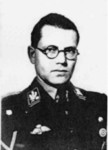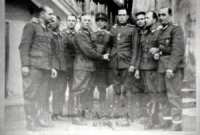Euthanasia - the "mercy killing" of people "not worth living" became a murderous
program in Nazi Germany. This campaign is believed to have resulted in the
killing of approximately 200,000 people. Evidence from the
Nuremburg trials
estimated that even 275,000 people were murdered.
 |
| Order from 18 August 1939 |
 |
| 1 September 1939 |
According to the decree from
18 August 1939, the Nazis enacted the obligatory
registration of all births of physically and mentally handicapped
children. These children up to three years had to be reported to the public
health offices. The selected children were sent to several mental homes where
they were killed by lethal drugs or withdrawal of food.
Up to 8,000 children lost their lives in course of this "children euthanasia". On the basis of
Hitler's order from
October 1939
the program was
extended on adults. This order was backdated on
1 September 1939, day of the German attack on Poland. The beginning of WW2
diverted the population from the euthanasia programme. The Nazis could get rid of "useless eaters" to save money
and personnel, and get more free beds in hospitals.
In course of the occupation of Poland mobile gas chambers were used for
the killing of mental homes inmates there.
Already in
1924/25 Hitler
wrote "
if there is no more power to fight for
the own health, the right to live comes to an end."
(
Hitler, Adolf.
Mein Kampf, p.282). The benefit of
eliminating approximately 70,000 handicapped persons was mentioned by
Hitler
on the NSDAP party conference in
1929.
Four cover organizations were established in the German
Reich in
1939:
- "Reichsarbeitsgemeinschaft Heil- und Pflegeanstalten" (RAG)
Sent registration forms to all mental homes which returned the filled in forms
to RAG. RAG forwarded them to medical experts who decided about life or death
of the patients.
- "Gemeinnützige Krankentransport GmbH" (Gekrat)
Transport organisation. Large Gekrat buses (former post buses) carried the
handicapped persons from their mental or nursing homes to the euthanasia
killing centers.
- "Gemeinnützige Stiftung für Anstaltspflege" (Stiftung)
Rented complete buildings or parts of them, converted rooms into extermination
sites, installed equipment, selected suitable personnel and managed economical
matters.
- "Zentralverrechnungsstelle Heil- und Pflegeanstalten" (ZVST)
Central Clearing Office for major financial matters like self-financing of T4.
 |
| Tiergartenstrasse 4 |
 |
| Karl Brandt |
 |
| Philipp Bouhler |
The head office was located in a
Berlin villa on
Tiergartenstraße 4.
Hence "T4" or "
Stiftung" became the terms used by the inner circle.
Hitler's favourite doctor
Karl Brandt
and the chief of
Hitler's
private chancellery,
Philipp Bouhler, headed the top-secret
euthanasia programme.
Doctors and medical assistants applied to assist with this programme.
The volunteers were attracted by a salary which was comparable with
the salary of a mayor governing a town of 20,000 residents!
Six euthanasia killing sites were established, mainly in mental homes:
Brandenburg near
Berlin (
January 1940 - September 1940),
Grafeneck near
Stuttgart
(
January 1940 - December 1940),
Hartheim near
Linz in Austria
(
January 1940 - December 1944),
Sonnenstein/Pirna near
Dresden (
April 1940 - August 1943),
Bernburg near
Magdeburg (
September 1940 - April 1943),
Hadamar near
Koblenz (
January 1941 - August 1941).
Each of these killing facilities were served by some intermediate
mental homes, the
Zwischenanstalten. The victims were sent
from their mental homes at first to these
Zwischenanstalten, then
to euthanasia centres finally.
Zwischenanstalten had two
functions: 1. Managing the capacities of the six euthanasia centres
and 2. Disguising the remaining of the victims if relatives inquired.
The T4 victims were murdered in
gas chambers, disguised as
shower baths, by means of carbon monoxide, emitted from gas cylinders.
The roots of the Nazi gas chambers are to be found in the testimony
of
Richard v. Hegener, employee of the "Chancellery of the Führer":
"
Originally one has taken into consideration to kill the single incurable
persons ... by injections or overdosed sleeping pills. But this consideration
... has been called impracticable from the technical point of view ..., by the
majority of the consulted doctors. Therefore it was proposed ... to kill the
persons being eligible simultaneously in a bigger crowd somehow. After many
consultations ... hearing the chemist of the Reichskriminalpolizeiamt too,
one decided to install a room in a number of conveniently located sanatoriums.
The room should be filled with carbon monoxide gas then ... "
(
Ludwigsburg Archive, file Hea-Hep)
Relatives of the victims were told that they had died as a result of illnesses such
as heart failure etc. Finally the relatives got an urn from an euthanasia centre,
filled with mixed ashes from different victims.
The procedure of deception and gassing became a model for the later killings at the
Aktion Reinhard extermination camps
Belzec,
Sobibor, and
Treblinka. In these camps the victims
were killed in gas chambers by carbon monoxide gas, emitted from Russian tank motors.
(Testimonies from the three "gas masters"
Bauer
(
Sobibor),
Fuchs
(
Belzec and
Sobibor) and
Münzberger
(
Treblinka)).
 |
| Propaganda Poster 1936 |
 |
| T4 Members in Trieste / Italy |
Hitler officially halted the T4 programme on
24 August 1941.
The intended rate of around 70,000 persons to be killed, was
achieved. Nevertheless the killing continued until
1945 during a
second phase. Now inmates of KZs (“Aktion 14f13”),
disabled individuals in the conquered territories in the East, and other remaining inmates of institutions
were also systematically murdered by overdoses of pain- killers and tranquilizers, or by deliberately
caused conditions of exhaustion and malnutrition (e.g. in
Meseritz-Obrawalde). Since "free beds" in
sanatoriums were needed in the cause of finding accommodations for
Germans injured in the war (
Aktion Brandt), the number of
victims increased.
Between end of October 1941 and summer
of 1942, approximately 100 T4 members were sent to
Lublin to install and operate the three extermination camps of
Aktion Reinhard. The T4 operation members
Wirth,
Stangl and
Eberl
became the first commanders of
Belzec, Sobibor and
Treblinka.
Wirth
was appointed inspector of the
Aktion Reinhard extermination camps.
By the
end of 1943, after they had finished their bloody work in
Poland, most of the T4 men were sent to northern Italy to
implement actions against remaining Jews and partisans. Many of
them turned up again in the concentration camp
San Sabba
near
Trieste. The group disintegrated after the surrender of the German
Wehrmacht in Italy.
See a list of 10% of the victims who were killed by the systematic medical mass murder in Germany and Austria:
www.iaapa.org.il/claims.htm
Today the villa where T4 was located, isn't visible anymore. New buildings took up the location but a
commemorative plaque is to be seen.
Many thanks to these persons and institutions for
their kind support:
Dr.Ute Hoffmann, Bernburg Memorial
Gudrun Bauer, Brandenburg Memorial
Thomas Stöckle, Grafeneck Memorial
Dr. Georg Lilienthal, Hadamar Memorial
Dr. Christina Vanja, Hadamar Memorial
Dr. Hartmut Reese, Hartheim Memorial
Dr. Boris Böhm, Pirna-Sonnenstein Memorial
Prof. Dr. Wolfgang Neugebauer, Dokumentationsarchiv des Österreichischen Widerstandes (DOEW)
Dr. Ursula Schwarz, DOEW
Mag. Peter Schwarz, DOEW
Christoph Heinen, Nordrhein-Westfälisches Hauptstaatsarchiv
Other sources:
Hoffmann, Dr. Ute. Todesursache: Angina.
Magdeburg: Ministerium des Innern des
Landes Sachsen-Anhalt, 1996.
Hoffmann, Dr. Ute, and Schulze, Dietmar. Gedenkstätte
Bernburg.
Dessau: Regierungspräsidium Dessau,
1997.
Müller, Roland, et al. Krankenmord im Nationalsozialismus -
Grafeneck und die "Euthanasie" in
Südwestdeutschland
Stuttgart: Archiv der Stadt Stuttgart,
2001.
Winter, Bettina. Verlegt nach Hadamar - Exhibition
Catalogue.
Kassel: LWV Hessen, 1994
Neuhauser, Johannes, and Pfaffenwimmer, Michaela. Hartheim -
Wohin unbekannt.
Weitra: Bibliothek der Provinz, 1992.
Schilter, Thomas. Unmenschliches Ermessen.
Leipzig: Kiepenheuer Verlag, 1998.
Böhm, Dr. Boris, et al. Nationalsozialistische
Euthanasie-Verbrechen in Sachsen.
Dresden, Pirna: Sächsische
Landeszentrale für politische Bildung and
Kuratorium Gedenkstätte Sonnenstein
e.V., 1996.
Böhm, Dr. Boris, et al. Sonnenstein - Heft 3 /
2001.
Pirna: Kuratorium Gedenkstätte
Sonnenstein e.V., 2001
© ARC 2005
















